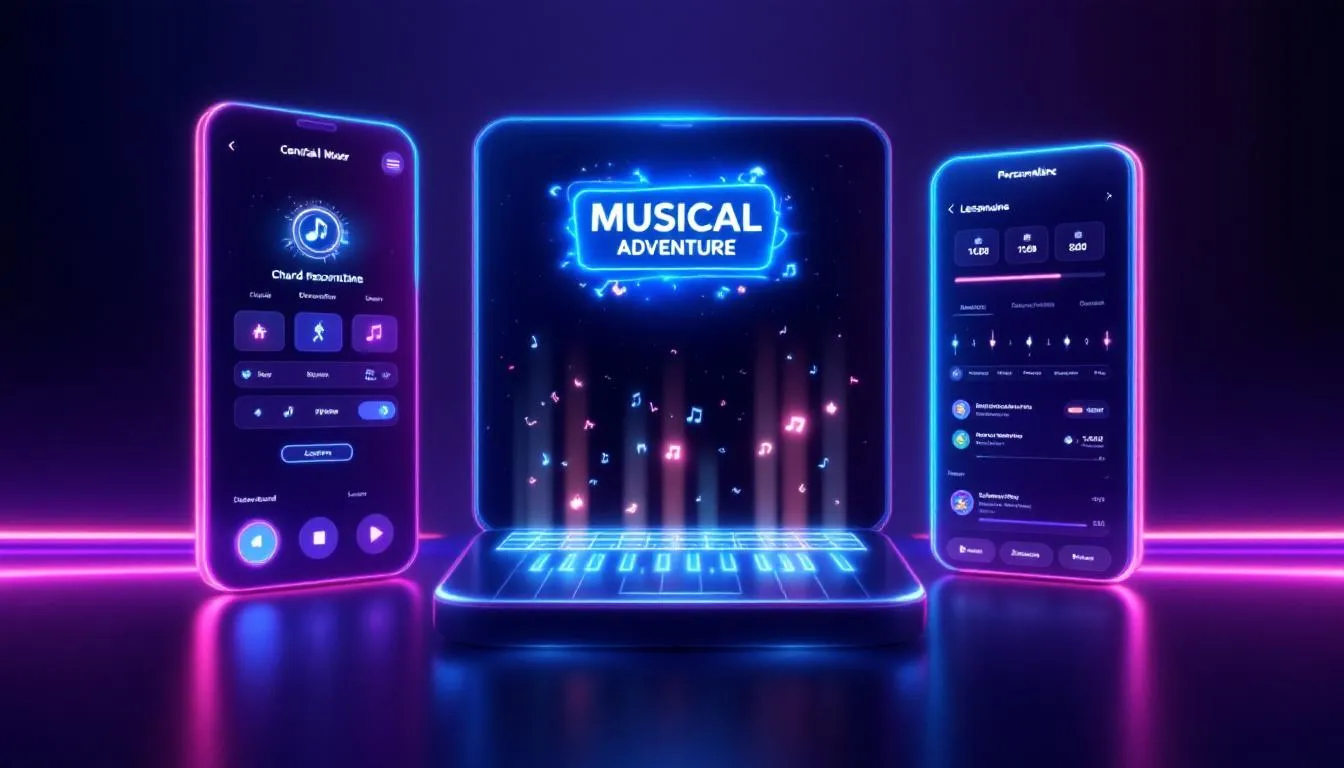## Quick Answer
Creating a music theory app is like composing a symphony; you need to harmonize educational content with user-friendly features. This involves understanding core music theory elements and translating them into an interactive digital experience. Enhancing your app requires listening to user feedback, making learning engaging, and ensuring seamless usability. By focusing on these areas, you can transform your music theory app into a valuable tool for both budding musicians and seasoned pros.
Identifying the hurdles faced in music theory app development is the first step toward crafting a successful and engaging learning platform.
What Are Common Pitfalls in Music Theory Apps?
Developing a successful music theory app involves more than compiling a list of scales and chords. For instance, the Piano Companion app, a versatile music theory tool for songwriters, producers, teachers, and students, successfully integrates a flexible piano chord and scale dictionary with advanced features like a chord progression builder and reverse mode. One significant hurdle is ensuring user engagement. After all, would you want to spend time on an app that feels like a textbook from the 1800s? Probably not. Thus, it’s crucial to incorporate interactive features that encourage users to actively participate in their learning journey. For example, when I teach, I often use call-and-response activities, which could be adapted into an app format to keep users engaged.
Gamification is another powerful tool for maintaining interest. Imagine transforming a dull theory exercise into a game where each correct answer helps you rescue a musical character from a flat or sharp villain! This approach makes learning fun and keeps users returning for more.
The user interface is also critical. A poor design can be a deal-breaker, like navigating a maze blindfolded. An intuitive interface with clear navigation ensures users can find what they’re looking for without frustration. Avoid common design mistakes like cluttered screens or confusing menus. Consider the user’s journey and ensure it’s as smooth as a well-played crescendo.
Educational content must be comprehensive and accurate, covering all necessary aspects of music theory while balancing theory with practical application. Think of it as teaching someone to ride a bike: they need to understand how it works, but ultimately, they learn by doing.
By addressing these pitfalls, your app can provide a richer, more engaging learning experience.
How Did FishScaleMusic Address These Challenges?
FishScaleMusic hit the right notes by embracing user feedback as a pivotal part of its development process. They didn’t just collect comments; they actively listened and adapted. Utilizing surveys, in-app feedback forms, and beta testing groups, they gathered a wealth of information from their users, ensuring they were attuned to user needs and preferences.
To analyze this feedback effectively, FishScaleMusic employed a team dedicated to categorizing and prioritizing user suggestions. This focus allowed them to implement impactful changes, such as enhancing the app’s gamification elements. They introduced a “Musical Adventure” mode, where users embark on quests to learn different music theory concepts, increasing user engagement and making learning thrilling.
Several users have shared success stories, highlighting how the app’s interactive features helped them grasp complex theory. One guitarist noted how the real-time chord recognition game significantly improved his improvisation skills.
In terms of design, FishScaleMusic made substantial improvements by streamlining the user interface. They created a clean, intuitive layout that guides users seamlessly through the app. This included optimizing user flow for easy navigation and implementing a personalized dashboard to track learning progress.
Accessibility was another key focus. FishScaleMusic ensured their app catered to diverse user groups by offering customizable settings, such as adjustable font sizes and color schemes. This inclusivity allowed users with varying needs to enjoy and benefit from the learning experience.
The innovative steps taken by FishScaleMusic set a high standard for music theory apps.
What Innovations Can Be Adopted from FishScaleMusic?
FishScaleMusic demonstrated that leveraging technology can transform music theory education into a dynamic and engaging experience. By integrating AI and machine learning, the app offers personalized learning experiences that adapt to individual users’ progress and preferences. If you’re breezing through chord recognition, the app increases complexity to keep you challenged, much like a music teacher tailoring lessons to a student’s growing skills.
A standout feature is the implementation of adaptive learning paths. Imagine starting with the basics of scales and, as you master each concept, the app intelligently guides you to more advanced topics. This system ensures learning is neither too easy nor overwhelming, keeping users motivated and on track.
Moreover, FishScaleMusic embraced community and collaborative features to enhance learning. By building a user community, learners can share insights, ask questions, and collaborate on projects. This social interaction mimics a classroom setting, where students learn as much from each other as they do from their textbooks.
Integrating social features, such as leaderboards and achievement badges, adds motivation. It’s like having a practice buddy encouraging you to reach new heights. The sense of competition and camaraderie drives users to engage more deeply with the content, transforming solitary study sessions into a shared journey.
These innovative approaches set a new benchmark for music theory apps. By focusing on personalized and community-driven experiences, FishScaleMusic created a platform that feels both supportive and challenging. As we think about enhancing music theory education further, it’s clear that these strategies offer significant benefits.
Key Takeaways
- Regularly solicit and analyze user feedback to refine and improve app features for a better user experience.
- Incorporate interactive and gamified elements to boost user engagement and make learning music theory fun and rewarding.
- Design a user-friendly interface paired with comprehensive, accurate educational content to ensure seamless learning.
- Draw inspiration from successful apps like FishScaleMusic to implement innovative solutions that personalize learning paths.
Take these insights to heart and let them inspire you to elevate your music theory app, transforming it into a tool that empowers and excites learners on their musical journey!
